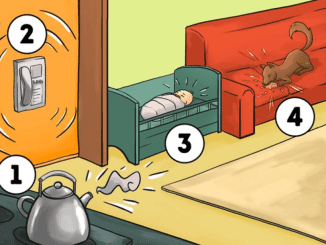Death is one of life’s greatest mysteries, and while we all understand that it is inevitable, the process leading up to it remains perplexing. A lesser-known but increasingly discussed phenomenon occurs in approximately one-third of patients nearing death, and it can be both confusing and distressing for loved ones. This phenomenon, known as “terminal lucidity” or “the rally,” is something that many people, including medical professionals, struggle to explain. Let’s dive into what happens during this strange but often beautiful experience, and how understanding it can provide comfort during an emotionally challenging time.

Known as ‘the rally’, this phenomenon may be due to fluctuations in brain functions before someone dies. (Tiktok/hospicenursejulie)
What Is Terminal Lucidity?
Terminal lucidity, sometimes referred to as “the rally,” is a sudden and often unexpected burst of energy or clarity that a person experiences just before they die. This phenomenon may include a return to coherent speech, increased physical activity, or improved appetite, making it seem like the person is recovering. However, this period of lucidity is typically followed by death within a few hours or days.
Julie McFadden, a palliative care nurse from Los Angeles, has witnessed terminal lucidity firsthand in many of her hospice patients. She describes it as an occurrence where someone who was previously weak or unresponsive suddenly regains the ability to interact with their loved ones, as though they are recovering. This window of clarity is fleeting, and it is often a sign that the end is near.
Signs of Terminal Lucidity: What to Expect
Terminal lucidity can manifest in several ways. Some common signs include:
- Increased energy and alertness: Patients who were previously bedridden and lethargic may suddenly be able to move around, sit up, or even walk short distances.
- Improved speech and communication: A person who had difficulty speaking or was unresponsive may start talking again, often engaging in meaningful conversations with family members.
- A sudden interest in food or drink: Hospice patients who had lost their appetite may suddenly request food or drink, even if they had been unable to eat for days.
- Personality return: Some patients regain a sense of humor, laugh, or exhibit their old personality traits, which can be both surprising and comforting for loved ones.
This period of lucidity is often mistaken for recovery, which can give false hope to family members who may believe their loved one is getting better. However, McFadden stresses that this brief improvement is usually followed by a rapid decline, often leading to death within a short time.
The Medical Mystery of Terminal Lucidity
While terminal lucidity is well-documented in hospice care, it remains a mystery from a scientific perspective. Medical professionals have yet to fully understand why this phenomenon occurs, and there are no definitive explanations for the sudden burst of energy and clarity before death.
Some experts suggest that changes in brain function, particularly oscillations between different brain states, may be responsible for this temporary sharpness. As the body prepares to shut down, there may be a brief resurgence of brain activity that allows patients to experience a final moment of clarity before they pass away. However, these theories are still speculative, and much more research is needed to provide a concrete explanation.

How Understanding Terminal Lucidity Can Help Families
For those who are unfamiliar with terminal lucidity, witnessing this sudden improvement can be both uplifting and devastating. Families may find themselves filled with hope, only to be heartbroken when their loved one passes away shortly after showing signs of recovery. McFadden emphasizes the importance of educating families about this phenomenon so that they are not blindsided by the person’s sudden death after experiencing the rally.
By understanding terminal lucidity, families can use this brief period of clarity as an opportunity to say final goodbyes, share meaningful moments, and find closure. Instead of being shocked or confused by the sudden change, families can cherish this time with their loved ones, recognizing it as a gift that allows for one last connection.

McFadden advises that while terminal lucidity can provide comfort, it is essential for families to be prepared for what comes next. “We try to educate the family about this before it happens so it doesn’t devastate them when they suddenly pass after doing so well for a few days,” she said in one of her videos. Knowing about terminal lucidity can transform this experience from one of confusion to one of meaningful closure.
Notable Instances of Terminal Lucidity in Pop Culture
Fans of the popular TV show Grey’s Anatomy may recall an episode where terminal lucidity was depicted with the character Mark Sloan, also known as McDreamy, played by Eric Dane. In the episode, Sloan experiences a sudden return to his normal self, talking and interacting with those around him just before he dies. This dramatization helped bring more awareness to the phenomenon of terminal lucidity, showing how common it can be in end-of-life situations.
A Final Gift: Finding Comfort in Terminal Lucidity
While the exact causes of terminal lucidity remain unknown, its occurrence can serve as a final gift for both the patient and their loved ones. It provides an opportunity to communicate, laugh, and connect before death, allowing families to feel a sense of closure that might otherwise be missed.

In the face of such a difficult time, knowing about terminal lucidity can help loved ones better prepare for the end, understanding that the rally is not a sign of recovery but rather a beautiful and brief moment of connection before saying goodbye.
Conclusion: Embracing the Mystery
The phenomenon of terminal lucidity remains one of the many mysteries surrounding death. While we may not fully understand why it happens, its existence offers comfort in knowing that those final moments can be shared in clarity and peace. For families facing the inevitable loss of a loved one, understanding and recognizing terminal lucidity can transform a confusing and emotional experience into one that provides an opportunity for closure and love.
Though science may not yet explain it, terminal lucidity continues to remind us of the beauty and complexity of the human experience, even in life’s final moments.


